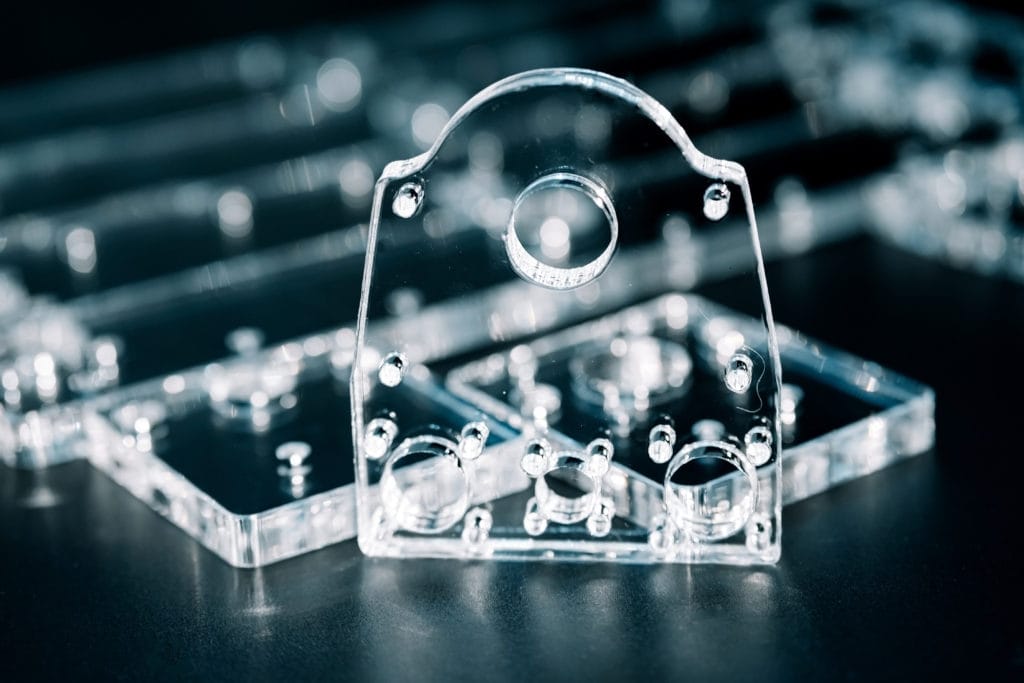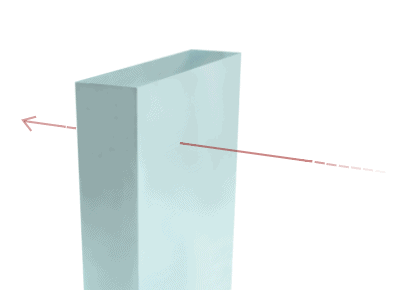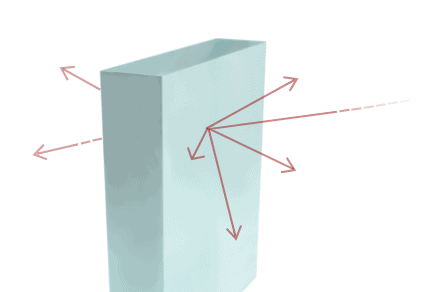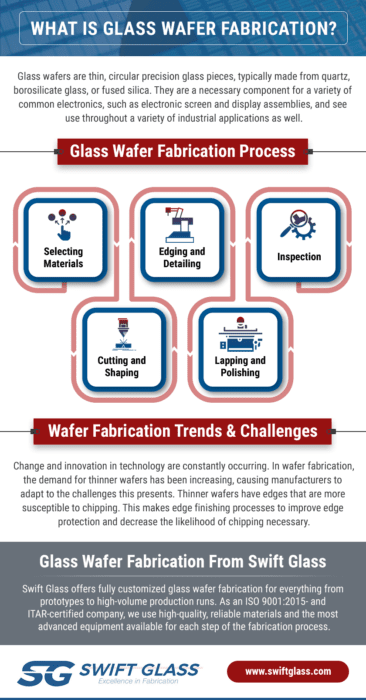CNC Machining vs. Ultrasonic Machining
Leave a Comment Over the past century, Swift Glass has established a reputation as a leading fabricator of precision glass products. As a pioneer in the glass industry, we have remained relevant and competitive by keeping abreast of the latest in glass machining technology. Our cutting-edge capabilities include precision glass computer numerical control (CNC) machining services and ultrasonic machining.
Over the past century, Swift Glass has established a reputation as a leading fabricator of precision glass products. As a pioneer in the glass industry, we have remained relevant and competitive by keeping abreast of the latest in glass machining technology. Our cutting-edge capabilities include precision glass computer numerical control (CNC) machining services and ultrasonic machining.
While they incorporate similar computer technology, glass CNC machining and ultrasonic machining have distinct characteristics that make them ideal for different applications. Below, we discuss the finer points of glass CNC machining vs ultrasonic machining to help you select the right process for your needs.
What is Glass CNC Machining?
Glass CNC machining, also known as glass milling, uses computer-directed tools to precisely remove material from a glass workpiece. CNC machining allows operators to cut and shape the workpiece on multiple axes, and can be used to create a wide range of sizes, shapes, and features such as grooves, slots, and holes.
The precision and versatility of glass CNC machining makes it ideal for use in a wider range of applications and industries, including:
- Aerospace/ Defense: CNC machining is used to create gauges, instruments, and other components with complex shapes.
- Biotechnology: Biotech companies use CNC-machined components such as flow cells to facilitate material flow through precision channels and cavities.
- Semiconductor: The semiconductor industry uses precision CNC-machined glass for wafer stages, reference frames, mirrors, and lenses.
- Telescopy: Telescopes and microscopes require highly accurate and stabilized mirrors and lenses that can only be produced using precision CNC machining.
What Is Ultrasonic Machining?
Ultrasonic machining, sometimes called ultrasonic drilling, uses a slurry of abrasive particles and ultrasonic vibrations to remove material from a glass workpiece. Unlike cutting and milling, the slurry removes miniscule amounts at a time, finely grinding the desired shape into the glass. The slow abrasion eliminates the potential for stress buildup in the workpiece, conserving the crystalline structure and strength of the glass.
Ultrasonic machining is highly versatile and can be used to create cavities and holes of varying shapes, sizes, and depths, including highly specific outer diameter (OD) and inner diameter (ID) features. Industries that benefit from the use of ultrasonic machining for glass components include:
- Aerospace: Ultrasonic machining is used to create pressure sensors, flight instruments, and other sensitive glass components in airplanes and spaceflight equipment.
- Automotive: Ultrasonic machined glass forms high-grade sensors for proximity detectors, back-up applications, and other safety features.
- Medical: A variety of medical devices incorporate glass components that have been machined using ultrasonic methods.
- Semiconductor: The semiconductor industry regularly incorporates ultrasonic machined glass for wafers, electrodes, distribution plates, lenses, and mirrors.
CNC Machining vs. Ultrasonic Machining
While both glass CNC machining and ultrasonic machining are used to create precision glass components, each method offers unique benefits for specific applications.
Glass CNC machining is highly versatile and can be used to create complex components within extremely tight tolerances. CNC machining has the added benefit of producing accurate components with minimal human oversight.
Ultrasonic machining is capable of producing accurate shapes, holes, and cavities in even extremely hard glass that can be difficult to mill. Since it does not require direct pressure, heat, chemicals, or electricity, ultrasonic machining applies less stress to the glass material, facilitating stronger components ideal for critical applications and high-pressure operations.
Since ultrasonic machining does not deform or stress the glass, it is the perfect option for components that require multiple holes and cavities. The gradual removal of extremely small amounts of surface material allows ultrasonic machining to drill to exceptionally precise depths. Unlike CNC milling, ultrasonic machining can drill multiple holes with a great degree of speed and precision without compromising the integrity of the workpiece. For complex glass components with many holes, this can be an extremely effective and cost-effective method of mass production.
Ultrasonic Machining Services at Swift Glass
Glass CNC machining and ultrasonic machining both offer distinct advantages. At Swift Glass, we pride ourselves on choosing the perfect method for the job at hand. We remain at the forefront of the glass fabrication industry by incorporating the latest technology. Leveraging over 100 years of experience, we work closely with our customers to find the perfect fabrication solution for every project. To learn more about ultrasonic machining and other custom fabrication capabilities at Swift Glass, contact us or request a quote today.
What is Glass Wafer Fabrication?
Leave a CommentGlass wafers are thin, circular precision glass pieces, typically made from quartz, borosilicate glass, or fused silica. They are a necessary component for a variety of common electronics, such as electronic screen and display assemblies, and see use throughout a variety of industrial applications as well.
Swift Glass has nearly 100 years of experience delivering expertly fabricated glass parts. We employ the latest innovations in glass fabrication technology in conjunction with the highest-quality materials, enabling us to deliver reliable glass wafers. Read on to learn more about the glass wafer fabrication process, as well as the latest wafer trends.
The Glass Wafer Fabrication Process
At Swift Glass, our experts craft glass wafers that meet even the most challenging design requirements. The fabrication process involves five steps:
- Selecting Materials: Depending on each customer’s design requirements, an appropriate high-quality glass is selected. We work with borosilicate (including Borofloat®), quartz and fused silica. Borosilicate is highly affordable and retains excellent mechanical strength in challenging environments. Quartz is shock-resistant and features a high melting point.
- Cutting and shaping: After the materials have been selected, the cutting process begins. Using our advanced portfolio of glass machining equipment, we can cut orders up to 100,000 wafers.
- Edging and Detailing: Next, the glass wafers are further refined through edge grinding and detailing processes. The fabrication process uses carefully calibrated CNC diamond machine tools and each wafer is delicately machined to design specifications.
- Lapping and Polishing: We use a free abrasive lapping process to develop appropriate surface smoothness before polishing each wafer on both sides.
- Inspection: Wafers undergo a high precision laser inspection in a clean room to ensure that they fall within total thickness variation (TTV) standards.
Wafer Fabrication Trends & Challenges
Change and innovation in technology are constantly occurring. In wafer fabrication, the demand for thinner wafers has been increasing, causing manufacturers to adapt to the challenges this presents. Thinner wafers have edges that are more susceptible to chipping. This makes edge finishing processes to improve edge protection and decrease the likelihood of chipping necessary.
Using silicon materials has become another trend in wafer fabrication. Silicon has excellent thermal properties and can be more cost-effective than glass. However, glass wafers have certain unique advantages over silicon. For example, its transparency makes discovering any bonding defects much easier. Additionally, some temporary bonding polymers require transparent substrates, making glass the preferred material for these applications.
Many customers need to customize their glass wafers with finishes that include channels, cavities, or holes on the wafer surface. Swift Glass leverages value-added processes like ultrasonic machining and microblast machining to target highly precise areas of delicate parts. Ultrasonic machining removes small amounts of glass using high-frequency vibrations, without compromising the glass’s chemical or physical structure. Microblast machining can target substrates on a microscopic level to etch glass surfaces.
Glass Wafer Fabrication From Swift Glass
Swift Glass offers fully customized glass wafer fabrication for everything from prototypes to high-volume production runs. As an ISO 9001:2015- and ITAR-certified company, we use high-quality, reliable materials and the most advanced equipment available for each step of the fabricThis blog post discusses the glass wafer fabrication process and the latest trends in glass wafer fabrication.ation process.
Our capabilities include CNC machining, ultrasonic machining, microblast machining, thermal tempering, chemical strengthening, and more. For more information about our glass wafer fabrication capabilities at Swift Glass and how they will benefit your application, please contact us or request a quote today.
6 Key Behaviors of Light on Glass
Leave a CommentLight has different properties that affect how we visualize objects. When waves encounter various barriers and mediums, like water, steel, or glass, they behave in different ways. Here, the team at Swift Glass shares the unique behaviors of light on glass.
Properties of Light
Light is a form of energy and part of a wider spectrum of electromagnetic radiation from the sun. Wavelengths tell us what type of light we’re dealing with. For example, microwaves and radio waves are on the long side of the spectrum, while UV rays and X-rays are much shorter.
When light hits an object, it may be absorbed, reflected, or refracted, depending on the type and shape of the material it hits. This is a key consideration when designing lenses, which are optical devices that use refraction to focus or disperse light. When creating lenses for microscopes, cameras, eyeglasses, and more, engineers have to consider the properties of the material and how light will interact with it.
Behaviors of Light
Light waves and particles interact with glass and other materials in different ways, depending on the type of light and the structure of the material:
- Transmission: The light passes directly through without being reflected, scattered, or absorbed. A transparent material, like a typical window, allows transmission of almost all light. An opaque material allows no transmission at all, and a translucent material, like a shower door, allows some transmission—however, that light gets scattered, which results in an unclear picture of what’s behind that translucent glass.
- Reflection: All types of waves, including light and sound, reflect off certain materials. When it comes to sound, certain animals, like bats, use that reflection (echoes) to find their way around. When it comes to light, smooth surfaces reflect it best: the perfect smoothness of a mirror gives us a clear reflected image, while the moving surface of the water gives us a blurry reflection. Reflection is also how we see color: a purple object, for example, is absorbing most of the wavelengths and reflecting the one we see as purple.
- Refraction: Light travels at different speeds through different mediums, and passing from one medium to another changes the direction of the light (refraction) and typically causes it to change speed. The bending of light through a convex lens can make objects appear larger.
- Diffraction: This is the bending and the spreading of the light waves—it’s what causes rainbows! You can also diffract light on purpose using a spectrometer to separate the wavelengths. This is useful in scientific applications to measure specific types of light.
- Absorption: When light photons hit the atoms and molecules that make up the highway, for example, those atoms vibrate and create heat. Dark materials (like a blackhighway) absorb more than light-colored materials (like the gray sidewalk)—which is why you may tend to prefer wearing a white shirt instead of a black shirt on a hot summer day.

- Scattering: This is when light bounces off the glass in multiple directions. There can be a little scattering or a lot, depending on which type of wave is scattering and what type of object it’s scattering off and through. This is why the sky is blue: nitrogen and oxygen scatter the short blue and violet waves, while the longer red and yellow waves pass right through. Violet waves are actually shorter and scatter more than the blue ones, but our eyes are more sensitive to blue, so that’s what we see when we look up on a clear day.
The way light behaves is fascinating, which is what makes the optical industry so exciting. Learn more about light and its properties and behaviors, or contact us for more information about custom glass fabrication. Swift Glass is a worldwide leader in high-quality glass manufacturing, and our experienced team works to ensure we meet your specifications and expectations as well as industry standards. We work on projects in a range of industries and applications. Request a quote today.





